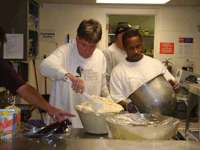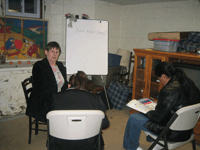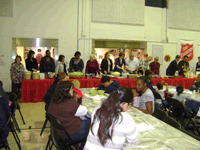Helping homeless children get through school is often not a topic discussed, or even brought to the attention of the public. Many aren’t even aware of how many homeless children attend our schools daily - but they do - and continue to with the help of programs such as Project Rise.
Project Rise (PR) is a federally funded program through the Ohio Department of Education under McKinney-Vento Homeless Assistance Act. PR’s federal program began in the late 1980’s in an attempt to provide proper education for homeless children and youth through various programs. Akron city schools applied for funding in the early 1990’s.
“The main purpose of Project Rise is to remove educational barriers of children and youth who are identified as homeless,” Deborah Manteghi, District Homeless Education Liaison and Program Manager, said.
“That is the main focus - then we do other things along the way to help support and sustain those children and youth in their school experience,” she continued.
PR focuses on helping with children’s academic needs, not only to keep them stable in school, but bring them up to the level where they need to be.
“We have a student assessment intake that we use to help identify the needs of the kids in our tutoring program at the shelters,” Manteghi said, “There are certified teachers that go to the shelters, and about 17 part time staff that work at the shelters after school to help the students with their homework.”
PR serves approximately 500-700 students annually.

The Effects of Homelessness
“Research shows that children who’ve experienced homelessness are more behind in school, they attend less school and are more likely to repeat a grade. Our older teens are more likely to drop out of school and are more subject to destructive behaviors,” Manteghi said.
Manteghi has found that they are also more likely to get pregnant, have mental health issues and involvement with juvenile court. Also, many of the families have involvement with Children’s Services or Child Protective Services.
“They are a very at-risk group of children, youth and families that we are attempting to provide services for,” she said.

Entering the Program
Those elegible for services include anyone who is lacking permanent nighttime residence.
“There are certain mandates to help remove the barriers to children and youth who are identified as homeless,” Manteghi said, “We include families that are doubled up due to hardship, we provide services to those that are at shelters and unaccompanied youth, usually ages 16-18.”
“This can include anyone in shelters, hotels, motels, living in a car, doubled up, on the streets, in abandoned buildings – things along those lines,” Manteghi said.
Homeless Children’s Rights
Until the late 1980’s no one had brought the issue of homeless children’s rights to the attention of the public. That all changed with Legislator Stewart B. McKinney, who worked towards increasing discussion and awareness on family homelessness. McKinney sought to find what the shelters and those working with the children were finding.
“What they found was that homeless children weren’t attending school, they were crossing over county and state boundaries and not having proper paperwork, they didn’t have an address, immunization records, and those things that are usually required when enrolling in a school,” Manteghi said.
It was important that someone keep track of these children and make sure they had equal rights when they couldn’t look out for themselves. Thus the McKinney-Vento Homeless Assistance Act came into existence, which is a United States Federal law that provides federal money for homeless shelter programs. It was signed into law by President Ronald Reagan on July 22, 1987.
Every school district is now required to have an assigned homeless education liaison. Eighteen districts in Ohio are funded. Project Rise is one of those.

Balancing Homelessness and School
Most homeless children are identified through the shelters and schools. Once identified, PR can coordinate and work with the school districts and appointed liaisons to provide them with the help they need.
“The kids may not want you to know that they are doubled up or what their living situation is. It is very stigmatizing and embarrassing,” Manteghi explained.
PR makes it easier for the kids to adjust to such a difficult situation.
The children are encouraged to stay in their school of origin, even when they move to a different city to stay at a shelter.
“It’s better to stay in their school of origin to keep continuity. We have a family right now in a motel in Copley but we’re getting them here to school in Akron because the parent chose to keep them here in school,” Manteghi said.
PR arranges transportation so that the children can get to the school of their choice.

Benefits of Project Rise
Other bonuses offered by PR include expedited assessments, waiver of school fees if needed and uniform and school vouchers. Tutoring programs are offered at ten different shelter sites, as well as after school programs with certified teachers, and enrichment programming.
“We have performing arts, the Love and Learn Doll Project, we do arts and literacy in the summer, as well as educational and cultural field trips,” Manteghi explained.
There is also Parent Rising, a special program for homeless parents.
“We also have an early childhood initiative that is being funded by United Way, ACCESS and Battered Women’s Shelter. We work with the library, Akron University, and Weathervane Magical Theater. We have the Service Learning Project with Kent State University and the University of Akron, and are adding Walsh in Canton. They are going to do some grant writing for us,” Manteghi said.
To read Part Two of the story click the link.
For more information on Project Rise please call 330.761.2969
If you have any story ideas, questions, or comments you can contact me at Katie@akroneur.com.